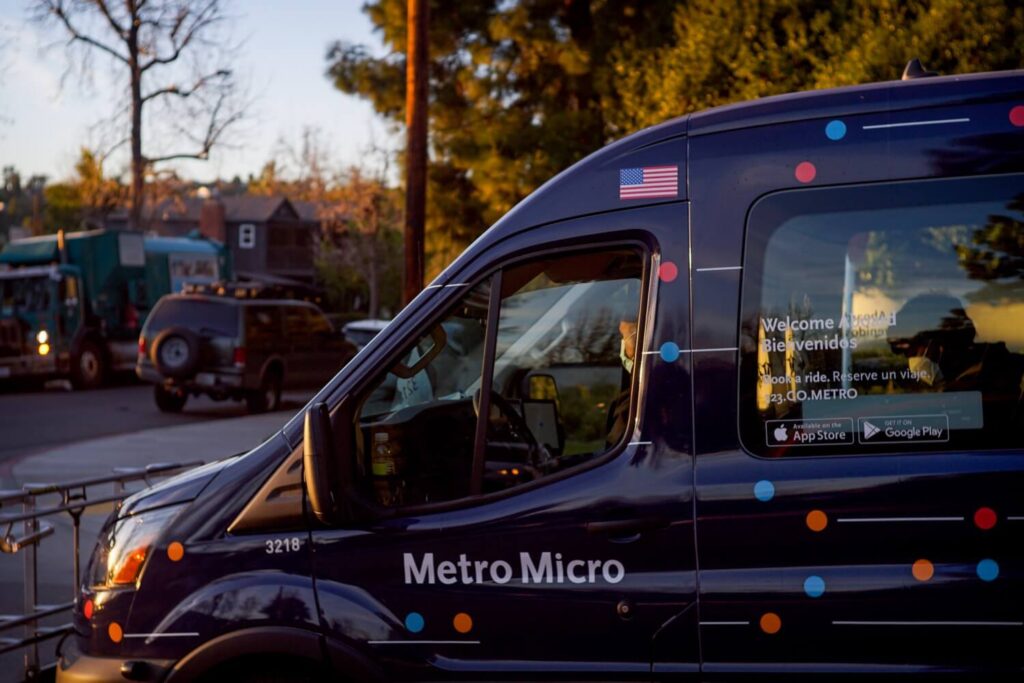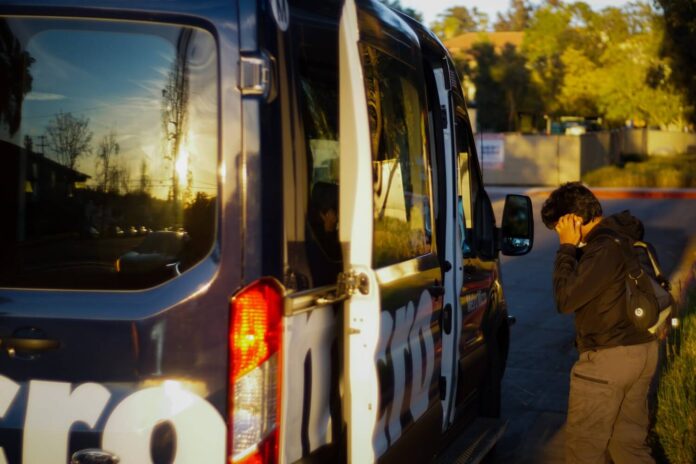A few days ago, just after 2 p.m., I stood beneath a stop sign at the edge of the Occidental campus, reading a book. It was scorching out, but I didn’t mind. I knew that in less than 10 minutes, an air-conditioned van would pick me up and carry me to the pharmacy almost a mile away — and it was only going to cost me a dollar. This van would be one of many vehicles operating as part of the “Metro Micro,” an experimental initiative by the LA Metro.
The Micro provides an on-demand ride-share service within designated “service zones,” one of which covers the Eagle Rock/Highland Park/Glendale area. As I waited, I tracked my ride on the Micro website, waiting anxiously for it to approach. When the van came, another person boarded with me, meaning the four-seater van was full. I had paid in advance online, but the van also had a spot to tap your Metro card. I buckled my seatbelt and the van pulled away.
First, it dropped off one of the other riders a few blocks away, and then it dropped me off at a bus stop across the street from my destination. The ride took me less than half the time it would’ve taken if I had used the Metro bus, and it cost less, too. All things considered, it was nearly as efficient as a Lyft or Uber, for a fraction of the price. It certainly felt more luxurious than the Metro. The van was equipped with seatbelts and a security camera, and unlike the Metro buses I’ve been on, there were no mysterious smells or stains.
It seems too good to be true, and in a way it is. Though the Micro only costs the customer a mere dollar per ride, each ride costs Metro a staggering $30-60 according to the Los Angeles Metro Board website. In other words, Metro is hemorrhaging money to operate the Micro. Why? Ridership is trending upwards (albeit slowly), and if it continues, the Micro could attract more riders to Metro’s other services: according to a Metro survey available on the Metro Board website, 11 percent of Micro riders were entirely new to the LA transit system and 19 percent used it to connect to other Metro services.
To those riding it, Micro provides a valuable service that can’t always be replicated by a bus, and removing it could leave thousands of customers stranded. I, for example, have no car, and as a broke college kid, I don’t have the money for constant Lyfts and Ubers. Since moving here in the fall, I found that Eagle Rock is not the most walkable of neighborhoods. I’ve had to make many trips to many stores and have realized that sometimes you have no choice but to take a vehicle (the nearest Best Buy, for example, is somehow over an hour away on foot). Therefore, I have come to rely on Micro, but unfortunately, it seems I’m in the minority.

Metro Micro hasn’t quite lived up to its expectations in terms of increasing ridership, as average weekday ridership has hung around only 2,000 people (woefully short of Micro’s goal of 5,000), according to the LA Metro board website. However, the Metro board just voted to extend the program until Sept. 2024, giving it a few more months to prove itself. Still, Micro struggles to keep up with demand because there are no fixed routes. Riders can be anywhere — and be heading anywhere — which means it’s hard to predict where the vans should be to maximize efficiency. In fact, after taking the Micro to the store, I had to walk back to campus, as the next Micro wasn’t available for another 20 minutes.
LA Metro Communications Manager Patrick Chandler said the Metro Board just voted to increase its base fare for the Micro from $1 to $2.50, a change meant to make Micro more cost-efficient without scaring away riders. Despite the fare increase, Chandler said he remains optimistic about the program.
“Compared to other privately owned ride-share companies, this is still cheaper,” Chandler said.
According to the Metro board, there will be multiple discount programs in place meant to keep rides affordable even after the fare increase. According to Chandler, Micro riders and operators have plenty of good things to say about the program.
“[People] like the service when it’s working. When it picks them up on time, they’re happy,” Chandler said. “A lot of times, [the drivers] get to know their riders. There’s relationships that are created between our customers and our operators.”
Despite its occasional unreliability (though I’ve waited longer for delayed buses than I ever have for the Micro), I truly enjoyed riding the Metro Micro. It’s quick, easy and cheap, but for the Metro board, it might not be worth the massive price tag. The board will have to decide that for themselves when the new contract expires in September. Hopefully, the fare increase will bring winds of good fortune, but if the next set of statistics look anything like the current ones, they might not paint a flattering picture of Micro’s effectiveness. I hope, though, that the Metro board will not forget the tangible positive impact that Micro has on riders like me.
Ultimately, I believe that the Metro doesn’t exist to make money, but rather to provide a service. Micro seems to be providing that service in an effective (if criminally underutilized) way. In a place as car-centric as LA, it’s easy to see why the Metro struggles to find new riders. Often, people are too individualistic and too married to their cars to consider public transport, but the Micro is the best of both worlds — so next time you’re looking to save some gas money (or if you’re just feeling lazy), try the Micro.
Contact Jay Ward at jward3@oxy.edu
![]()




































This service cost taxpayers up to $60 per shared ride (vs $10-$20 for door to door service by Uber for example). It only works for a limited group of people (elderly, disabled, school/college students on their way back from school, those who choose not to work etc). In other words, it only work for people who do not need to be on time even approximately, or do not need to be at their destination at all. Vans routinely arrive 30-45 min late or do not arrive at all. A ride can take anywhere from 15 min to over an hour, depending on how optimal is the route. And the route is rarely optimal as the drivers are forced to make u-turns or “go around the block” to pick up or drop of on the “right” side of the street. The application they use is horrible in that respect and did improve in three years of the “pilot” program.
Increasing the fare to $2.50 will only cause the small percentage of the riders that actually pay $1/ride to stop using the system. Who in world wants to pay $5 round trip if driving few miles back and forth would only cost you $1-$1.50 ? No big deal. The majority of the riders are not even paying $1 now. So, the program won’t even notice the loss. It will simply become one of the niche transportation program for a selected group of people. Just like access. As such, it should not operate as a “public transportation” and should seek different funding to continue its operations.
The best option for the taxpayers would be to subsidize Uber/Lift rides for those who qualify and be done with it. This will be much cheaper than kicking the can down the road at $60 a kick! But even shut it down and return the fixed route buses that MetroMicro replaced is a better solution.